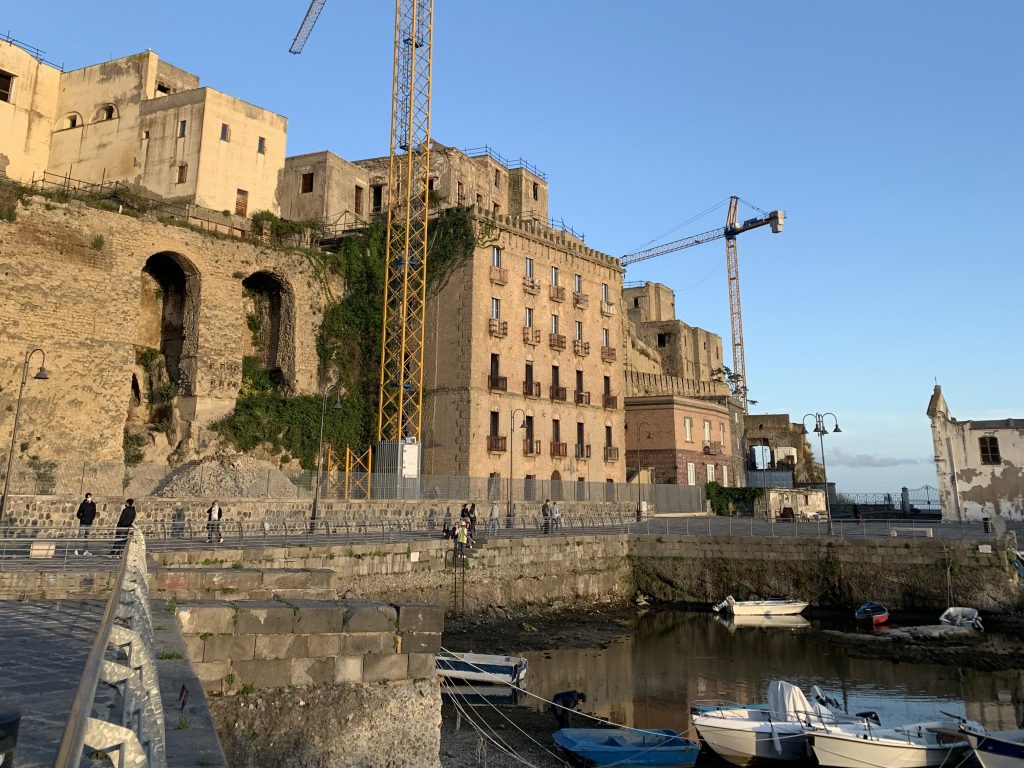The ground never stopped breathing, in the Phlegraean Fields, a large volcano situated west of Naples. But in the last sixteen years, signals have been recorded that alerted the five hundred thousand people living in the volcanic crater. It’s been months since several mild earthquake tremors followed one another. Some of these shakes were felt by the population and anticipated by roars; others, instead, have only been recorded by seismographs. In addition, some biochemical anomalies have been recorded in the fumaroles – deep cracks in the ground spurting out high temperature steam and volcanic gases – of Pisciarelli, in Agnano’s zone, and in Pozzuoli’s Solfatara. Pozzuoli’s inhabitants had to cope with the draining of the wet dock due to the progressive ground swelling, a phenomenon known as bradyseism.

The waterline is going down in Pozzuoli’s wet dockThe rising concern among citizens has prompted Pozzuoli’s mayor, Vincenzo Figliolia, to invite on February 10th Angelo Borrelli, Civil Protection’s head, and Francesca Bianco, Vesuvian Observatory’s director, to take stock of the situation. «At the moment there’s no cause for alarm», reassured Borrelli about the bradyseismic condition in Pozzuoli, pointing out that the alert level in the Phlegraean Fields is under observation, but that «so far, there are no reasons to change the scenario». In 2012, in fact, the Department of Civil Protection raised the alert level from green to yellow.
ALARMISM HIGHER THAN THE RISK
These signals, matched with misleading reporting done by some local newspapers – fueling the fear for a much and much closer volcano eruption – reminded the local inhabitants of the two severe bradyseismic crises: the one occurred between 1969 and 1972 and the other one between 1982 and 1984, that led the ground to an overall rising of about 3,5 meters. The evolution of the story of this phenomenon in the Phlegraean Fields can be split in cyclical phases and, at the beginning of ’70, a positive bradyseism was recorded: the ground started rapidly swelling up to 1,70 meters, making it necessary to build new bollards in Pozzuoli’s port.

Since 1905, Rione Terra neighborhood became a landmark for scientists to track down the bardyseismThe catastrophic consequences of this event were particularly visible in the Rione Terra neighborhood, the first residential settlement in Pozzuoli that became a landmark for the Vesuvian Observatory’s researchers. They identified in that place the highest rising point. On March 3, 1970, an evacuation was ordered, amidst the general dismay, of six thousand inhabitants of the neighborhood. The access routes were bricked up. After a slow subsidence, the ground started to swell again at the beginning of the ’80, up to 1,80 meters. A bradyseismic crisis was accompanied by almost 10 thousand earthquakes. The situation became cause for concern and some of Pozzuoli’s citizens as well were ordered to evacuate and repositioned in a safer location.
BRADYSEISM: CRISES IN COMPARISON
But here’s the question: can the ongoing bradyseismic crisis, in terms of intensity, be compared with the previous two that occurred in the recent past? What’s the current situation in the Phlegraean Fields? Firstly, we must consider that the seismicity, the frequency of earthquakes, in bradyseismic crises is a consequence of the fact that the ground is rising up and, by doing so, it is causing the breakage of the rock’s volume. A major energy that subtends the swelling results not only in a faster movement, but in a widespread crushing that can cause a major number of earthquakes with an higher magnitude. With a minor swelling, instead, the opposite occurs: the ground is gradually adapting itself to the push that it receives, fracturing itself less than before and causing fewer earthquakes, with minor energy.
Experts underlined how the ongoing bradyseismic crisis – started in November, 2005 – is very much different from the previous two. The Vesuvian Observatory’s, which constantly monitors the Phlegrean volcanic crater, recorded a minor swelling compared to the ones registered during the ’70 and the ’80. «Both between ’69 and ’72 and between ’82 and ’84, the ground, in a two years span, rose up to two meters. Since 2005, the lifting was only up to 79 centimeters. What we are witnessing are two completely different swelling speeds», explains Francesca Bianco, Vesuvian Observatory’s director. In particular, since September the swelling occurred with a speed of 13 millimeters per month: then, about 15 centimeters per year. The seismic characteristics as well are different than what we observed 40 years ago. «Now – continues doctor Bianco – most of the seismic events we record have a magnitude inferior than 1». This means that they can be detected only by extremely sensible sensors, which were not available to researchers in the ’80, making it impossible to record them.
The speed of ground rising is not constant, though. Recently there have been alternating periods with a rapid swelling of 16 millimeters and periods with a slowing down to 6 millimeters per month. Foreseeing when the next will occur and which magnitude it will have is practically impossible.

